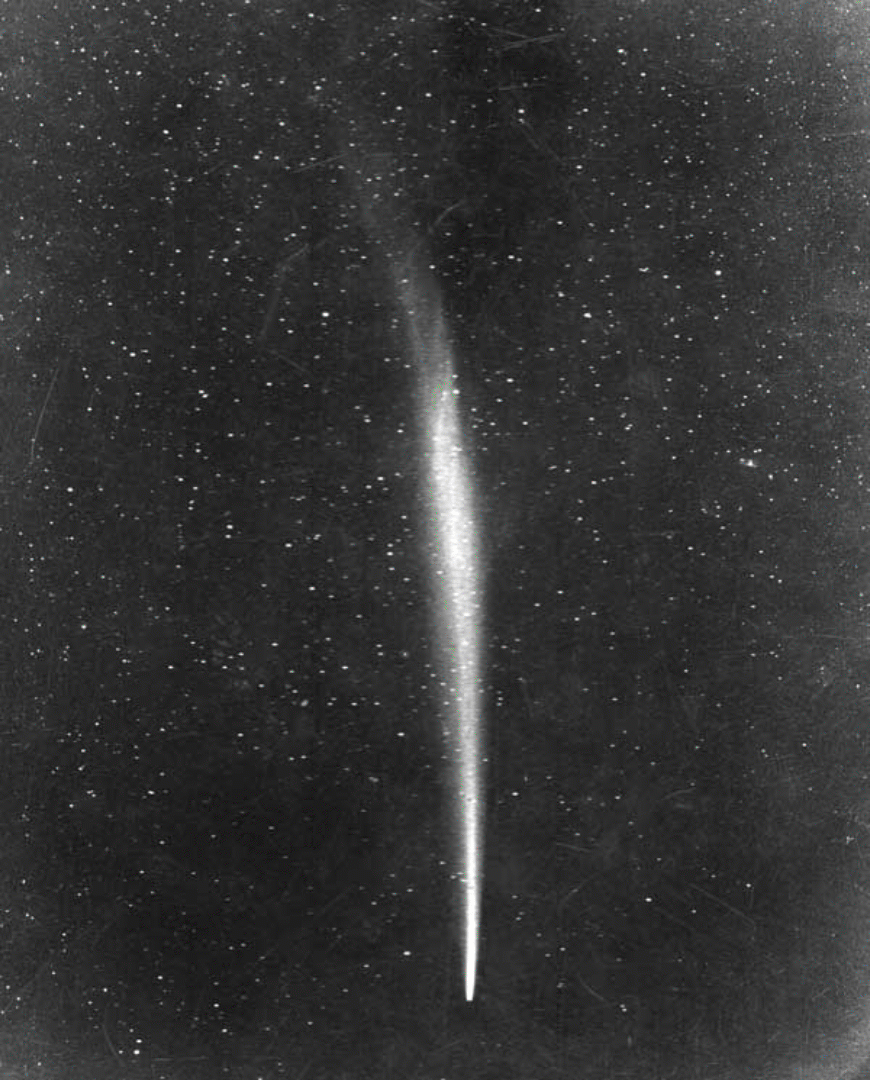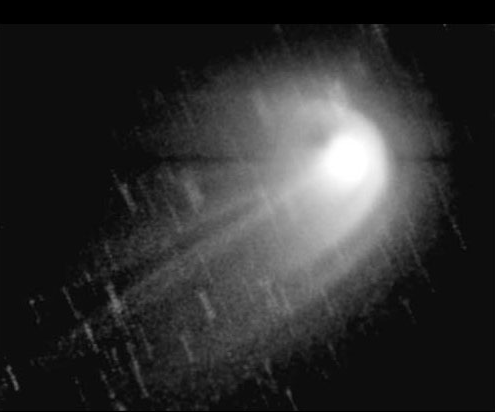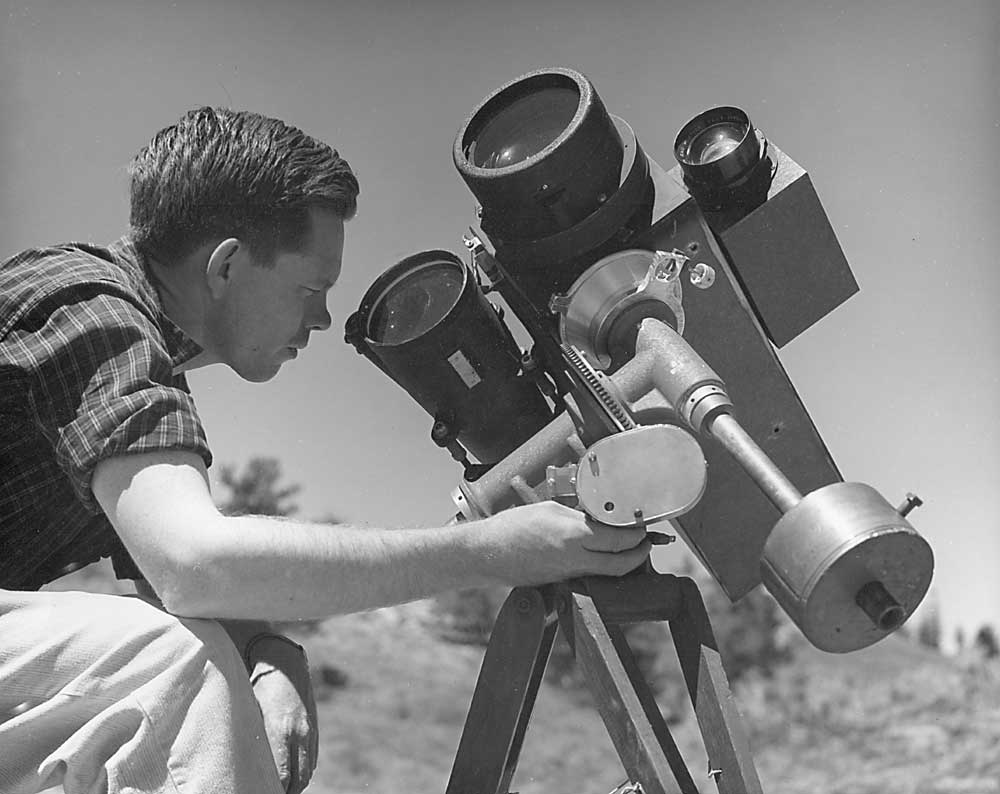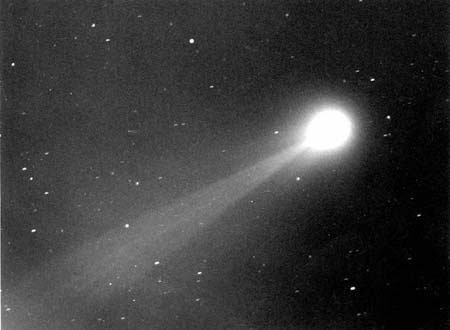Comets
"Comets are like cats...
they have tails and do precisely what they want."

David H. Levy
co-Discoverer of comet Shoemaker-Levy 9
"Comets are like cats...
they have tails and do precisely what they want."

David H. Levy
Co-discoverer of comet Shoemaker-Levy 9
Comet Photography and Ties to Stony Ridge Observatory
Those Wonderful, Fickle, Unpredictable "Hairy Stars"
Comets are icy bodies that populate a range of orbits or exist in congregation far from the Sun. Most are invisible, loitering either in what is believed to be a large and distant spherical shell of material called the Oort Cloud or as disassociated members in the vast regions of interstellar space. Regardless, they are waiting for a gravitational nudge to send them sunward.
When a comet comes within the realm of the major planets, it absorbs sufficient solar energy and the ice begins to sublimate (transitions from solid directly to gas) which liberates dust, a process thus yielding two streams of material. These are the “tails” for which comets are so noted (although dust is sometimes observed around the nucleus as well).
Some comets travel in closed, highly elliptical paths and, therefore, make periodic approaches to our star. Others on open-ended parabolic or hyperbolic trajectories will have the encounter but once, never to be seen again.
Predicting the peak luminosity of comets can be fairly difficult due to a number of factors: distance from the Sun when discovered; “newness;” the relative distances in an ever-changing Sun-comet-Earth triangulation; the shape of the orbit to name a few.
For example, when a comet displays volatility far from the Sun, it can be an indication that the gas is easily liberated and perhaps exists in great quantity. A “fresh” comet making its initial approach can shine brightly at first but dim quickly if its supply of surface ice is limited. And fragile comets that pass too close to the Sun can break apart if gravitational forces are too stressful.

C/1965 S1 (Ikeya-Seki)
Easy Sloman
Sometimes known as "the Great Comet of 1965," Ikeya-Seki was a fabulous example of a well-hyped performer that lived up to expectations. It graced the early morning skies in the Fall of that year and sported an intensely bright nucleus and long, thin tail.
This undated photo was probably taken around November 1 as determined by comparison with ephemeris data which placed the comet near Gienah (γ Covi) on that date. The identification of the star field and coordinate overlay was made by plate-solving, a computerized process of mapping imagery to a stellar database (provided here by astrometry.net). Of note, the coordinate grid uses degrees to represent Right Ascension (RA) in lieu of the normal units of hours and minutes. One hour of RA equals fifteen degrees.
The telescope/lens used for this image isn't known, but certainly was not the Carroll telescope which affords a much narrower field of view regardless of configuration.

C/1965 S1 (Ikeya-Seki)
Easy Sloman
Sometimes known as "the Great Comet of 1965," Ikeya-Seki was a fabulous example of a well-hyped performer that lived up to expectations. It graced the early morning skies in the Fall of that year and sported an intensely bright nucleus and long, thin tail.
This undated photo was probably taken around November 1 as determined by comparison with ephemeris data which placed the comet near Gienah (γ Covi) on that date. The identification of the star field and coordinate overlay was made by plate-solving, a computerized process of mapping imagery to a stellar database (provided here by astrometry.net). Of note, the coordinate grid uses degrees to represent Right Ascension (RA) in lieu of the normal units of hours and minutes. One hour of RA equals fifteen degrees.
The telescope/lens used for this image isn't known, but certainly was not the Carroll telescope which affords a much narrower field of view regardless of configuration.
"Hunters"
As in the case of asteroids, the naming of comets consists of both formal and informal designations. The informal always honors the discoverer, whether human, machine, or entity charged as part of an observing program, as in the case of comet NEAT pictured below. As such, considerable time has been spent by dedicated searchers, especially amateurs, to find comets either visually or with increasing application, through imaging. It was through photographic inspection that SRO astronomer Steve Brewster made his 1986 discovery of 105P/Singer Brewster, although not from Stony Ridge.
Formal naming has evolved over time, especially with the increase of discoveries afforded by modern means of detection with cameras having CCD or CMOS sensors. More recently, these conventions follow a decidedly more complicated scheme which basically consists of a prefix (e.g., P for periodic comets or C for non-periodic, amongst others); the year of discovery; the half-month of discovery (where ‘A’ is the first half of January, ‘D’ would be the last half of February, and so on except that ‘I’ and ‘Z’ aren’t used); and a numeric to indicate the order of discovery within the half-month. For example, Ikeya-Seki (shown above) was discovered on September 18, 1965 – the first comet found in the ‘S’ half-month – by Japanese amateurs Kaoru Ikeya and Tsutomu Seki.

C/2001 Q4 (NEAT)
the Faint Object Follow Up - FOFU - Team
Comet NEAT was discovered at
Palomar Observatory by the Near Earth Asteroid Tracking team of which Dr. Eleanor (Glo) Helin, friend and collaborator of SRO, was a member. This fine image, recorded within a week of the 16 May, 2004 perihelion passage, was made using an Apogee AP8p CCD camera attached to the f/6 prime focus of the 30-inch (.76m) Carroll telescope. It features dust shells around the nucleus as well as structure within the tail.
Analysis* of similar imagery obtained from other institutions on different dates was used to calculate the axis of spin rotation. Furthermore, using brightness measurements combined with assumed versus measured rates of outgassing, astronomers calculated a nuclear diameter of 7km at time of closest approach to the Sun. Finally, they determined that NEAT had been dislodged from the Oort Cloud and was making its first trip to the inner solar system. (*The Astronomical Journal 133, pp 612-621, July 2007)
In terms of brightness, NEAT was better than most. Like many comets having a large coma cloud around the nucleus, luminosity estimates were somewhat difficult to assess. Light curves showed a peak at around 2d magnitude - very respectable indeed.

C/2001 Q4 (NEAT)
by the Faint Object Follow Up - FOFU - Team
Comet NEAT was discovered at
Palomar Observatory by the Near Earth Asteroid Tracking team of which Dr. Eleanor (Glo) Helin, friend and collaborator of SRO, was a member. This fine image, recorded within a week of the 16 May, 2004 perihelion passage, was made using an Apogee AP8p CCD camera attached to the f/6 prime focus of the 30-inch (.76m) Carroll telescope. It features dust shells around the nucleus as well as structure within the tail.
Analysis* of similar imagery obtained from other institutions on different dates was used to calculate the axis of spin rotation. Furthermore, using brightness measurements combined with assumed versus measured rates of outgassing, astronomers calculated a nuclear diameter of 7km at time of closest approach to the Sun. Finally, they determined that NEAT had been dislodged from the Oort Cloud and was making its first trip to the inner solar system. (*The Astronomical Journal 133, pp 612-621, July 2007)
In terms of brightness, NEAT was better than most. Like many comets having a large coma cloud around the nucleus, luminosity estimates were somewhat difficult to assess. Light curves showed a peak at around 2d magnitude - very respectable indeed.
"Gatherers"
The photography of comets has always been unique in terms of risk and reward, especially in the days before digital cameras, computer controlled telescope mounts, and image processing software.
Like a fidgety child who won’t sit still for a portrait, comets move relative to the stars – often in degrees per day when at their best. Their appearance can be dynamic, changing in relatively short time scales, at least compared to the dim and distant objects that evolve slowly. (There are exceptions to the latter, for example, the expected outburst of recurring nova T Coronae Borealis in 2024.) In short, with a film camera, you shoot “in the blind,” hoping your settings and execution are correct. There is no immediate feedback like that inherent in digital equipment. At worst, you may only get one chance to get a decent shot to bag your prey!

Alan McClure
Pictured here with a triple astrograph designed by Roy Ensign, Alan examines the mount which he must expertly guide to ensure his target remains centered while it drifts in relation to the stars.

Alan McClure
Pictured here with a triple astrograph designed by Roy Ensign, Alan examines the mount which he must expertly guide to ensure his target remains centered while it drifts in relation to the stars.
One of the most accomplished comet photographers of his day – the film era – was Alan McClure. He was an early member of the group that would one day become Stony Ridge, Inc., and held office on the Executive Committee where he served as Expediter.
Alan’s photos were renowned, his results widely published in Sky and Telescope magazine, among others, and much heralded by those who saw them and could appreciate the difficulty in obtaining them.
Discussing Alan’s approach on a website dedicated to a fixed, immobile telescope complex is somewhat ironic. As the montage below shows, he was more than willing to “take the observatory to the comet.” There were practical reasons for doing so, given the fact that comets shine brighter in the days either side of perihelion and depending on the geometry of the encounter, it can appear quite close to the horizon where mountains can interfere. There is also the matter of inclement weather, which can be quite localized – and avoided – if your setup is transportable.
Timing is a critical issue. According to Kepler’s laws of motion, the closer an object is to its sun, the faster it moves. With comets, this is quite evident from night to night or even hour to hour. Thus, you don’t have unlimited opportunities to photograph these objects!


Of interest in the animation above, Alan’s telescope mount was built by George Carroll and features the indicative ribbed hub below the Right Ascension axis.
Note also, in the case of Arend-Roland, the “forward pointing tail” known as an anti-tail, though this is a misnomer. There is no part of the tail that precedes the comet. Instead, you are seeing the debris as Earth passes through the plane of the comet’s orbit. Speaking of planes…to help visualize what’s actually happening, imagine a paper airplane flying right to left in front of you. In most orientations, the wings appear to flare back from the nose. But if the plane starts flying toward you and its nose begins pointing toward your line of sight, its right wing will appear as though it is “ahead” of the nose.

C/1973 E1 (Kohoutek)
Sara Martin
At the time, Kohoutek held the record for being the most distant comet ever discovered, a tantalizing fact which fueled speculation of it becoming a spectacular object late in 1973. The anticipation quite probably resulted in the production and purchase of more amateur telescopes than any other previous event, and therein lies Kohoutek's infamy. Simply put, the comet underwhelmed an oversold public and was considered a "bust" of astronomical proportion. However...
Astronomers had ample time to prepare, and through observatory-class instruments, Kohoutek did not disappoint. It made a fine target for the Carroll 30-inch (.76m) telescope as seen here. Spectroscopy data harvested from other observatories led to both a detailed analysis of the comet's chemical makeup and the physical processes of its outgassing.
For most ground-based observers, the comet attained a brief period of peak luminosity at around 3rd magnitude. (The Skylab 3 astronauts were able to extend observations as Kohoutek neared the Sun and found it to be significantly brighter around the time of closest approach.) However, after perihelion on December 28th, the comet quickly dimmed and before the end of January was no longer a naked eye object even with optimal observing conditions.

C/1973 E1 (Kohoutek)
Sara Martin
At the time, Kohoutek held the record for being the most distant comet ever discovered, a tantalizing fact which fueled speculation of it becoming a spectacular object late in 1973. The anticipation quite probably resulted in the production and purchase of more amateur telescopes than any other previous event, and therein lies Kohoutek's infamy. Simply put, the comet underwhelmed an oversold public and was considered a "bust" of astronomical proportion. However...
Astronomers had ample time to prepare, and through observatory-class instruments, Kohoutek did not disappoint. It made a fine target for the Carroll 30-inch (.76m) telescope as seen here. Spectroscopy data harvested from other observatories led to both a detailed analysis of the comet's chemical makeup and the physical processes of its outgassing.
For most ground-based observers, the comet attained a brief period of peak luminosity at around 3rd magnitude. (The Skylab 3 astronauts were able to extend observations as Kohoutek neared the Sun and found it to be significantly brighter around the time of closest approach.) However, after perihelion on December 28th, the comet quickly dimmed and before the end of January was no longer a naked eye object even with optimal observing conditions.







